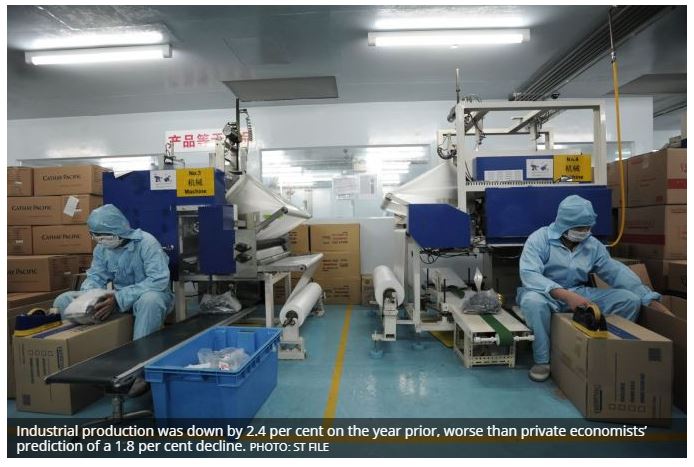Singapore factory output worse than expected, down by 2.4% in May
SINGAPORE factory output fell again in May, after a brief reprieve the month before.
Industrial production was down by 2.4 per cent on the year prior, worse than private economists’ prediction of a 1.8 per cent decline, according to preliminary Economic Development Board numbers out on Wednesday.
When biomedical manufacturing was left out, factory output fell by a sharper 4.9 per cent, as the volatile pharmaceutical industry propped up the sector with 15.9 per cent growth, despite a drop in the medical technology segment on lower export demand.
But the Republic’s linchpin electronics cluster, hit by a double whammy of cyclical slowdown and the US-China trade war, continued to suffer.
Electronics shrank by 10.8 per cent – the third straight month of contraction this year – although March’s double-digit drop was revised upwards to 14.1 per cent, from an initial 15.3 per cent.
Data for February had also previously been revised upwards – to a 4.2 per cent improvement that broke the sequential losing streak – after original reports of continued depression.
The cluster’s output is now lower by 4.5 per cent year on year for the first five months of 2019, on drops in the key semiconductor industry, as well as computer peripherals and data storage.
Besides biomedical manufacturing’s year-on-year growth of 8.8 per cent, the general manufacturing cluster also posted expansion – to the tune of 4.9 per cent – on production of drinks, metal containers, clothes and batteries.
Transport engineering output rose by 2.9 per cent, fuelled by a 17.2 per cent surge in aerospace production amid more repair and maintenance jobs from commercial airlines.
This was even as a slump in offshore and shipbuilding and repairing work pushed the marine and offshore engineering segment into a contraction of 10.9 per cent.
Meanwhile, precision engineering output was down by 4.7 per cent, as lower output in refrigeration systems, process control equipment and semiconductor-related equipment offset the higher production of optical and plastic precision products.
The chemicals cluster was flattish, with a 0.4 per cent dip in production – largely on maintenance shutdowns in some petrochemical plants, which eroded the gains clocked by specialities, petroleum and other chemicals.
“The global technology downturn, slowing global growth and the effects of last year’s US-China trade spat have all taken a toll on the export-oriented sectors of the economy,” ANZ said in a research note, scrapping its hopes of a second-half export recovery.
Economist Tan Khay Boon, senior lecturer at SIM Global Education, noted that the impact of the trade tensions between the United States and China “has changed from a negative sentiment to an actual decline in manufacturing demand” as talks made little headway.
With the US resuming a hawkish stance on Iran under the Trump administration, “the friction in the Middle East may drive up oil prices which can stimulate the marine and offshore engineering segment but the overall outlook is still negative unless something good can emerge out of the US-China meet”, said Dr Tan.
ANZ added: “Although we are hopeful that some sort of deal can still be agreed upon, the reality is that the tensions will linger, with further escalation likely. Therefore, Singapore’s exports will stay weak and detract from growth in 2019.”
Regional economists at ING had warned earlier in the day that May’s 15.9 per cent plunge in non-oil domestic exports put the factory data estimate at “more downside than upside risk”.
Separately, Barclays analysts had already noted after a decline in Taiwanese manufacturing that Huawei-related “rush orders” in that market may have fallen after April, based on an artificial boost from front-loading as the United States mooted curbs on dealings with key Chinese technology companies.
Barnabas Gan, an economist at United Overseas Bank, cited factory contractions in Taiwan, South Korea, Japan and elsewhere as signs of a broader slowdown, saying: “Despite the contraction, we note that the decline in manufacturing momentum is not isolated to Singapore, but rather, also seen broadly across other key Asian economies.”
On a seasonally adjusted, monthly basis, Singapore’s industrial production was down by 0.7 per cent in May, or 2.6 per cent when biomedical manufacturing was excluded.
Manufacturing output is now 0.7 per cent lower in the year to date than in the year-ago period.
Source: https://www.businesstimes.com.sg/government-economy/singapore-factory-output-worse-than-expected-down-by-24-in-may


 Thailand
Thailand




